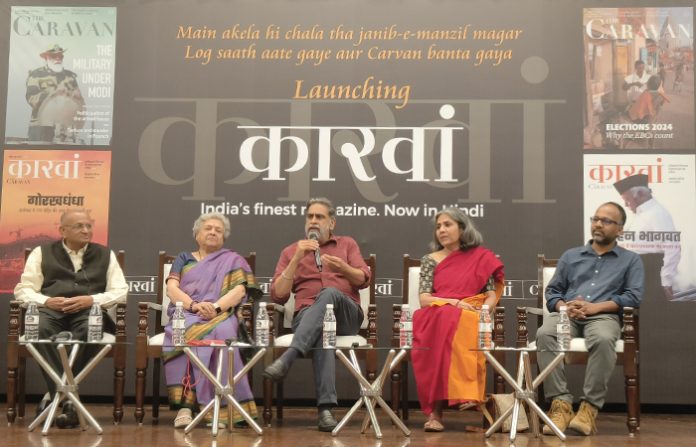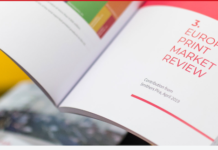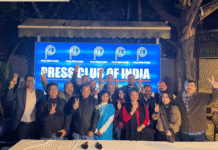
The launch of The Caravan’s Hindi quarterly Karwaan in April 2024 was accompanied by a panel discussion that compared the state of Hindi journalism today and in the yesteryears when the medium was thriving. Moderated by Hartosh Singh Bal, executive editor of The Caravan, the panel with Paresh Nath, editor-in-chief of Delhi Press, Seema Chishti, editor of The Wire, Mrinal Pande, former chief editor of Hindustan, and Sagar, staff writer at The Caravan as speakers deliberated on what Hindi journalism needs to today to revive and revitalize.
Paresh Nath, editor-in-chief of Delhi Press, said Hindi magazines still record the highest sales in India. “Our Hindi fortnightly Sarita was priced at Re 1 when it launched in 1945. This was not an easy feat during those days and involved a huge amount of risk as the magazine was being brought out by Vishva Nath, a person who was not even remotely associated with Hindi literature and came from a printing background.”
Sarita has been a revolutionary magazine since its inception, Nath said, adding it tried to demonstrate how the Indian society remained poor and backward due to overemphasis on religion. Delhi Press tried to educate Indian readers on how they were politically free but not entirely mentally free.
“Our magazines are a result of our family’s hard work and commitment as no investor or institution funded them. We are proud to say we are now the publishers of 25-30 magazines with The Caravan being a renowned name in the English magazine space while in Hindi, we have Sarita, Grihashobha and Champak,” he said.
“Grihashobha and Champak have a wide readership in many other Indian languages such as Tamil, Telugu, Malayalam, and Bangla. All magazines have different forms and had their ups and downs during their publication,” he added.
Nath informed the audience that their family was closely associated with publishing even before Delhi Press was established. The Nath family were publishers of the 1870 edition of an English-Hindustani dictionary, which was priced at Rs 50.
Mrinal Pande, former chief editor of Hindustan and author of The Journey of Hindi Language Journalism in India: From Raj to Swaraj and Beyond (Studies in Journalism), said the 80s were the golden period of Hindi magazine publishing in India there were good editors such as Harveer Sahay, Srikant Verma and Sarveshwar Dayal Saxena. “We at the The Times of India group used to look at Delhi Press in a snooty way. However, I used to believe and still believe that Delhi Press introduced me personally and Hindi magazines generally to its target audience and to what extent you can push him/her,” she said.
She said Delhi Press was prompt in paying freelance writers and photographers. In the 80s, press photographers were in a bad state and used to go to multiple publishing houses. The big publishers had a long wait time and could not make instant payments.
“During our office discussions, I came to know that the sales of Delhi Press’ Women’s Era were higher than The Times of India Group’s Femina, she said, adding Grihashobha and Champak were the largest-selling Hindi magazines. I realized we should not look at Delhi Press in a snooty way, and rather try to understand what they had got right that the Times Group magazines hadn’t.”
Most Hindi magazines of that era were brought out by larger publishing houses, which used to put their English newspapers first, Pande said, adding Hindi magazines and newspapers were in the second and third categories. “Till a publishing house does not have its full focus on its publications and editorial teams, you will not be able to understand its requirements. Till the time good editors were present, Hindi magazines kept on doing well but later started to decline. In the 90s, there came a time when many leading Hindi magazines shut down one by one – Dharmyug, Saptahik Hindustan, and Gyanoday,” she added.
While the Times Group fussed a lot about their printing operations and the quality of paper, the main focus of the Delhi Press publications used to be on their pace and portability, she explained. This was when women were first becoming a part of the Indian workforce, though mostly in clerical jobs – they used to travel by DTC buses in Delhi and local trains in Mumbai. “When I interacted with some of these women, they said the size of Sarita enabled them to carry it in their bags and read it on the way to their workplace. It was easily available at all railway stations and newsstands while the Times publications were available only at select bookshops and newsstands and were not of a suitable size to fit in a handbag,” she said.
The Hindi reader doesn’t have deep pockets like his or her English counterpart, Pande said, adding they still spend their money on Hindi publications to keep themselves informed and updated. “I am happy that the Delhi Press Group hasn’t retained the name The Caravan for its Hindi version and has used the Hindi word Karwaan instead,” she added.
Apart from pace and portability, Hindi magazines of yesteryears had fewer advertisements, she said, adding a major reason was that larger publication houses used to subsidize their Hindi publications. Another reason behind the success of weekly magazines was serialized fiction from established and emerging Hindi authors, which needs to be revived today. The Hindi reader is still thirsty for this type of content, Pande said, adding readers still maintain bound versions of their favorite Hindi editions and consider them as a collector’s item.
These days, many Hindi magazines are coming up again as the newspaper industry is not doing well, Pande said. Long-form content, she said, is still alive in magazines as people in smaller cities like to read long articles in print despite digitization. When men go to work, housewives read and even exchange Hindi magazines, she said. “We need to put some thought into finding out the Hindi magazine reader, what she does, and when she finds to time to read. It is very difficult to prepare a psychotropic profile of our readers, especially women,” she said.
Pande said art and literature columns have disappeared or been reduced in major Indian newspapers, and it’s up to magazines to revive these sections.
Seema Chishti, editor of The Wire, said that the 90s was a very interesting decade for Indian radio and Hindi journalism. She felt gross injustice was done to the Hindi public sphere during that time as many possibilities and opportunities in Hindi journalism were missed. Hindi radio was a medium that connected the Hindi-speaking belt, Chishti said but the government didn’t allow news on radio to be privatized. “There are many spoken Hindi dialects in India and there was a huge scope for Hindi radio to nurture them, which did not happen.”
BBC Hindi brought a lot of possibilities to Hindi radio journalism and helped radio emerge as a cost-effective medium for informing and updating the masses on the latest news, she said. The closure of several Hindi news magazines defines the betrayal of these opportunities in Hindi journalism, she said, adding leading bookstores of that time refused to stock Hindi books and magazines. This trend is still relevant at many elite bookshops in north India, even though some of them have started stocking translations and South Asian literature in recent years.
Sagar, a staff writer at The Caravan, explained that working with regional English newspapers and interacting with Hindi writers helped him understand the approach towards Hindi journalism in general. There is not much fact-checking in Hindi journalism because of which there is misinformation, he said, adding publications get away with this due to their mass popularity. However, Karwaan has a proper fact-checking team in place.
Pande said words have their own journey in a language – their meanings keep on changing according to time. It is, thus, extremely important for writers and journalists to learn the nuances of Hindi or whichever language they are reporting in. Journalism is playful and it should be something to hit back at the authorities with, she said.
Hartosh Singh Bal, executive editor of The Caravan, recalled that when Dainik Bhaskar and Dainik Jagran were launched in Punjab, the relationship between journalism and language came to the fore. Explaining, he said Hindu journalism was often linked to Hindu fundamentalism and Punjabi journalism to Sikh fundamentalism. He said language politics between Hindi and Urdu had played a key role during the British rule as well.
Reporting shouldn’t have any language be it Hindi, Punjabi, Urdu or English, Bal said, adding Karwaan will continue in the footsteps of The Caravan to create an unbiased anti-establishment approach to Hindi journalism.
















